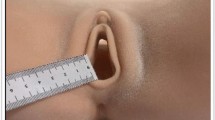Abstract
Introduction and hypothesis
This time-series analysis was carried out to determine if the use of the EPISCISSORS-60®, episiotomy scissors specifically designed to achieve a cutting angle of 60°, would continue to sustain obstetric anal sphincter injuries (OASIS) reductions at our hospital 2 years after its introduction.
Methods
We compared data from 2,342 women delivered in 2014 (prior to the introduction of EPISCISSORS-60®) with that of 4,498 women delivered from 2016 to 2017 (after the introduction of EPISCISSORS-60®).
Results
There was a reduction of OASIS in all nulliparous vaginal deliveries (NVD; 7.2% vs 5.1% p = 0.05), and a 50% reduction of OASIS (7.5% vs 3.7%) in operative vaginal deliveries (OVD) (p = 0.02). There was a statistically significant association between episiotomies performed with EPISCISSORS-60® and a reduction in OASIS (SVD: 6.9% vs 1.5% p = 0.006; OVD:28.6% vs 2.6% p < 0.0001). Additionally, there was an increase in the use of episiotomies in all nulliparous vaginal deliveries (29% vs 33.7%; p = 0.01). We also found a 78% reduction of OASIS with episiotomies compared with no episiotomies in the 2016–2017 group (6.9% vs 1.5% p = 0.006).
Conclusions
Our results suggest that there might have been a sustained reduction in OASIS rates associated with using EPISCISSORS-60®.

Similar content being viewed by others
References
RCOG (2015) Greentop guideline 29: The Management of Third- and Fourth-Degree Perineal tears. Available at: https://www.rcog.org.uk/globalassets/documents/guidelines/gtg-29.pdf.
Anderson A (2013) Ten years of maternity claims: an analysis of NHS litigation authority data. National Health Service Litigation Authority (NHSLA). Available at: https://doi.org/10.1177/1356262213486434.
Ampt AJ, Roberts CL, Morris JM, Ford JB. The impact of first birth obstetric anal sphincter injury on the subsequent birth: a population-based linkage study. BMC Pregnancy Childbirth. 2015;15:31. https://doi.org/10.1186/s12884-015-0469-4.
Basu M, Smith D, Edwards R, STOMP project team. Can the incidence of obstetric anal sphincter injury be reduced? The STOMP experience. Eur J Obstet Gynecol Reprod Biol. 2016;202:55–9. https://doi.org/10.1016/j.ejogrb.2016.04.033.
Fritel X, Schaal JP, Fauconnier A, Bertrang V, Levet C, Pigne A. Pelvic floor disorders 4 years after first delivery: a comparative study of restrictive versus systematic episiotomy. BJOG. 2008;115:247–52.
Vogel D, van der Leeuw-van Beek A, Gietelink D, Vujkovic M, de Leeuw JW, van Bavel J. The effect of a mediolateral episiotomy during operative vaginal delivery on the risk of developing obstetrical anal sphincter injuries. Am J Obstet Gynecol. 2012;206:404.e1–5. https://doi.org/10.1016/j.ajog.2012.02.00.
Räisänen S, Vehviläinen-Julkunen K, Heinonen S. Need for and consequences of episiotomy in vaginal birth: a critical approach. Midwifery. 2010;26:348–56. https://doi.org/10.1016/j.midw.2008.07.007.
Gurol-Urganci I, Cromwell DA, Edozien LC, Mahmood TA, Adams EJ, Richmond DH, et al. Third- and fourth-degree perineal tears among primiparous women in England between 2000 and 2012: time trends and risk factors. BJOG. 2013;120:1516–25. https://doi.org/10.1111/1471-0528.12363.
Eogan M, Daly L, O'Connell PR, O'Herlihy C. Does the angle of episiotomy affect the incidence of anal sphincter injury? BJOG. 2006;113:190–4.
Stedenfeldt M, Pirhonen J, Blix E, Wilsqaard T, Vonen B, Qian P. Episiotomy characteristics and risks for obstetric anal sphincter injury: a case-control study. BJOG. 2012;119:724–30. https://doi.org/10.1111/j.1471-0528.2012.03293.
Andrews V, Thakar R, Sultan AH, Jones PW. Are mediolateral episiotomies actually mediolateral? BJOG. 2005;112:1156–8.
Naidu M, Kapoor DS, Evans S, Vinayakarao L, Thakar R, Sultan AH. Cutting an episiotomy at 60 degrees: how good are we? Int Urogynecol J. 2005;26(6):813–6. https://doi.org/10.1007/s00192-015-2625-9.
Silf K, Woodhead N, Kelly J, Fryer A, Kettle C, Ismail KM. Evaluation of accuracy of mediolateral episiotomy incisions using a training model. Midwifery. 2015;31(1):197–200. https://doi.org/10.1016/j.midw.2014.08.009.
Freeman RM, Hollands H, Barron L, Kapoor DS. Cutting a mediolateral episiotomy at the correct angle: evaluation of a new device: the Episcissors-60. Med Devices (Auckl). 2014;7:23–8. https://doi.org/10.2147/MDER.S60056.
Patel RP, Ubale SM. Evaluation of the angled Episcissors-60(®) episiotomy scissors in spontaneous vaginal deliveries. Med Devices (Auckl). 2014;7:253–6. https://doi.org/10.2147/MDER.S66901.
Sawant G, Kumar D. Randomized trial comparing episiotomies with Braun-Stadler episiotomy scissors and EPISCISSORS-60(®). Med Devices (Auckl). 2015;8:251–4. https://doi.org/10.2147/MDER.S83360.
Van Roon Y, Kirwin C, Rahman N, Vinayakarao L, Melson L, Kester N, et al. Comparison of obstetric anal sphincter injuries in nulliparous women before and after introduction of the EPISCISSORS-60 at two hospitals in the United Kingdom. Int J Women’s Health. 2015;7:949–55.
Mohiudin H, Ali S, Pisal PN, Villar R. Implementation of the RCOG guidelines for prevention of obstetric anal sphincter injuries (OASIS) at two London hospitals: a time series analysis. Eur J Obstet Gynecol Reprod Biol. 2018;224:89–92.
Divakova O, Khunda A, Ballard PA. Episcissors-60™ and obstetrics anal sphincter injury: a systematic review and meta-analysis. Int Urogynecol J. 2019. https://doi.org/10.1007/s00192-019-03901-4.
Cole J, Lacey L, Bulchandani S. The use of Episcissors-60 to reduce the rate of obstetric anal sphincter injuries: a systematic review. Eur J Obstet Gynecol Reprod Biol. 2019;237:23–7. https://doi.org/10.1016/j.ejogrb.2019.04.004.
Sultan AH, Thakar R, Ismail KM, Kalis V, Laine K, Räisänen SH, et al. The role of mediolateral episiotomy during operative vaginal delivery. Eur J Obstet Gynecol Reprod Biol. 2019;240:192–6. https://doi.org/10.1016/j.ejogrb.2019.07.005.
Laine K, Skjeldestad FE, Sandvik L, Staff AC. Incidence of obstetric anal sphincter injuries after training to protect the perineum: cohort study. BMJ Open. 2012;2:e001649.
Author information
Authors and Affiliations
Contributions
LMK: manuscript writing/editing; YVR: data collection; AP: data collection; SP: data collection/analysis, manuscript editing.
Corresponding author
Ethics declarations
Conflicts of interest
None.
Additional information
Publisher’s note
Springer Nature remains neutral with regard to jurisdictional claims in published maps and institutional affiliations.
Rights and permissions
About this article
Cite this article
Koh, L.M., van Roon, Y., Pradhan, A. et al. Impact of the EPISCISSORS-60 mediolateral episiotomy scissors on obstetric anal sphincter injuries: a 2-year data review in the United Kingdom. Int Urogynecol J 31, 1729–1734 (2020). https://doi.org/10.1007/s00192-019-04201-7
Received:
Accepted:
Published:
Issue Date:
DOI: https://doi.org/10.1007/s00192-019-04201-7




